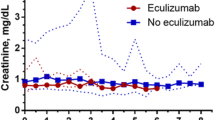Abstract
Objective
To assess the clinical and hemotological profile of PNH in children.
Methods
Clinical and laboratory features of children with PNH diagnosed in the past six years at our centre were reviewed. Various investigations done included a complete blood count and peripheral smear examination, plasma hemoglobin, urine hemosiderin, acid ham test, sucrose lysis test, immunophenotyping of erythrocytes by sephadex column gel card and of granulocytes by flow cytometry. There were 18 children with a marked male predominance (M 14: F 4).
Results
Pallor, jaundice, dark urine and bleeding manifestations were the major presenting complaints. One girl suffered an arterial stroke. All children had cytopenia in at least one cell line. Children were treated with danazol, stanazolol, prednisolone and cyclosporin A variously. Overall response rate was 61%. Children with classical PNH performed slightly better with response rates of 66% (6/9) as compared to aplastic anemia-PNH group which has a response rate of 55% (5/9). Amongst various variables only danazol correlated with better response (p=0.029).
Conclusion
PNH is an uncommon disease in children and should be included in the differential diagnosis of children presenting with cytopenia.
Similar content being viewed by others
References
Paquette RL, Yoshimura R, Veiseh C, Kunkel L, Gajewski J, Rosen PJ. Clinical characteristics predict response to antithymocyte globulin in paroxysmal nocturnal hemoglobinuria. Br J Haematol 1997; 96: 92–97.
Socié G, Mary JY, Gramont AD, Rio B, Leporrier M, Rose C et al. Paroxysmal nocturnal haemoglobinuria: long-term follow-up and prognostic factors. Lancet 1996; 348: 573–577.
Heuvel-Eibrink MMV, Bredius RGM, Winkel ML, Tamminga R, Kraker J, Schouten-van Meeteren AYN et al. Childhood paroxysmal nocturnal haemoglobinuria (PNH), a report of 11 cases in the Netherlands. Br J Haematol 2005; 128: 571–577.
Hall C, Richards SJ, Hillmen P. The glycosyl-phosphatidylinositol anchor and paroxysmal nocturnal haemoglobinuria/ aplasia model. Acta Haematologica 2002; 108: 219–230.
Miller DR, Baehner RL, Diamond LK. Paroxysmal nocturnal hemoglobinuria in childhood and adolescence. Clinical and erythrocyte metabolic studies in two cases. Pediatrics 1967; 39: 675–688.
Kletzel M, Arnold WC, Berry DH. Paroxysmal nocturnal hemoglobinuria presenting as recurrent hemolytic uremic syndrome. Clin Pediatr 1987; 26: 319–320.
Ware RE, Hall SE, Rosse WF. Paroxysmal nocturnal hemoglobinuria with onset in childhood and adolescence. N Engl J Med 1991; 325: 991–996.
Wyatt HA, Mowat AP, Layton M. Paroxysmal nocturnal haemoglobinuria and Budd-Chiari syndrome. Arch Dis Child 1995; 72: 241–242.
Graham ML, Rosse WF, Halperin EC, Miller CR, Ware RE. Resolution of Budd-Chiari syndrome following bone marrow transplantation for paroxysmal nocturnal haemoglobinuria. Br J Haematol 1996; 92: 707–710.
Endo M, Beatty PG, Vreeke TM, Wittwer CT, Singh SP, Parker CJ. Syngeneic bone marrow transplantation without conditioning in a patient with paroxysmal nocturnal hemoglobinuria: in vivo evidence that the mutant stem cells have a survival advantage. Blood 1996; 88: 742–750.
Lin HC, Chen RL, Wang PJ. Paroxysmal nocturnal hemoglobinuria presenting as moyamoya syndrome. Brain Develop 1996; 18: 157–159.
Flotho C, Strahm B, Kontny U, Duffner U, Peters AM, Dupuis W, Niemeyer CM. Stem cell transplantation for paroxysmal nocturnal haemoglobinuria in childhood. Br J Haematol 2002; 118: 124–127.
Rizk S, Ibrahim IY, Mansour IM, Kandil D. Screening for paroxysmal nocturnal hemoglobinuria (PNH) clone in Egyptian children with aplastic anemia. J Trop Pediatr 2002; 48: 132–137.
Wainwright L, Brodsky RA, Erasmus LK, Poyiadjis S, Naidu G, MacKinnon D. Paroxysmal nocturnal hemoglobinuria arising from Fanconi anemia. J Pediatr Hematol Oncol 2003; 25: 167–168.
Gupta V, Tilak V, Ramakrishna SV, Bhatia BD. Paroxysmal nocturnal hemoglobinuria in childhood: An uncommon presentation. Indian J Med Sci 2006; 60: 64–67.
Koduri PR, Gowrishankar S. Paroxysmal nocturnal haemoglobinuria in Indias. Acta Haematol 1992; 88: 126–128.
Verma N, Garewal G, Verma S, Vohra H. Flowcytometric detection of PNH defect in Indian patients with aplastic anemia and myelodysplastic syndromes. Am J Hematol 2000; 65: 264–265.
Nishimura J, Ware RE, Burnette A, Pendleton AL, Kitano K, Hirota T et al. The hematopoietic defect in PNH is not due to defective stroma, but is due to defective progenitor cells. Blood Cells Mol Dis 2002; 29: 159–167.
Young NS, Maciejewski JP, Sloand E, Chen G, Zeng W, Risitano A et al. The relationship of aplastic anemia and PNH. Int J Hematol 2002; 76(Suppl. 2): 168–172.
Wang H, Chuhjo T, Yasue S, Omine M, Nakao S. Clinical significance of a minor population of paroxysmal nocturnal hemoglobinuria-type cells in bone marrow failure syndrome. Blood 2002; 100: 3897–3902.
Kruatrachue M, Wasi P, Na-Nakorn S. Paroxysmal nocturnal haemoglobinuria in Thailand with special reference to as association with aplastic anaemia. Br J Haematol 1978; 39: 267–276.
Hall C, Richards S, Hillmen P. Primary prophylaxis with warfarin prevents thrombosis in paroxysmal nocturnal hemoglobinuria (PNH). Blood 2003; 102: 3587–3591.
Marwaha RK, Bansal D, Trehan A, Varma N. Androgens in childhood acquired aplastic anemia in Chandigarh, India. Tropical Doctor 2004; 34: 149–152.
Author information
Authors and Affiliations
Corresponding author
Rights and permissions
About this article
Cite this article
Naithani, R., Mahapatra, M., Dutta, P. et al. Paroxysmal nocturnal hemoglobinuria in childhood and adolescence-a retrospective analysis of 18 cases. Indian J Pediatr 75, 575–578 (2008). https://doi.org/10.1007/s12098-008-0111-9
Received:
Accepted:
Published:
Issue Date:
DOI: https://doi.org/10.1007/s12098-008-0111-9




